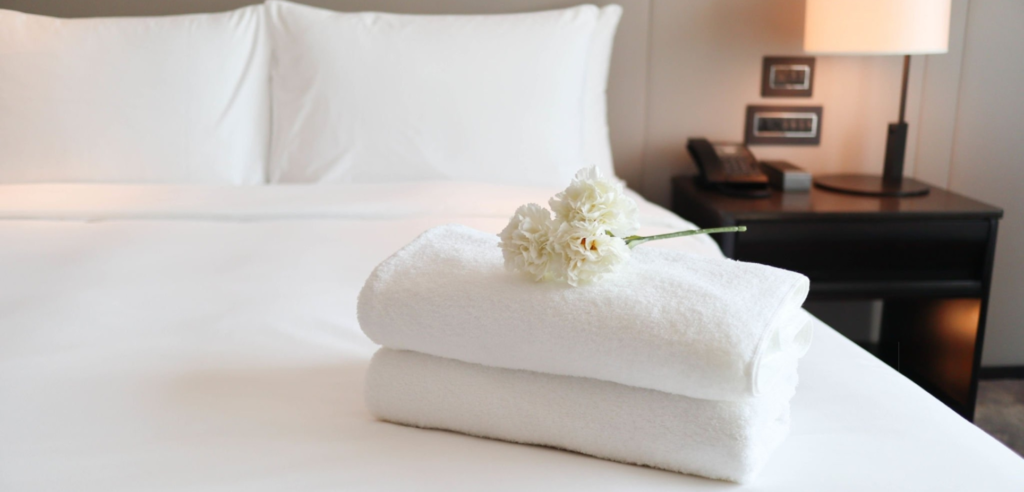Upon entering a hotel room, one often encounters an environment of pristine perfection, meticulously organized with an array of desirable amenities, ideal lighting, and the perfect room temperature. Stepping into a hotel room characterized by a pristine fragrance, impeccable tidiness, spotless bathrooms, dust-free tables, meticulously arranged bedding, and warm, modern decor is essential for ensuring comfort and fostering a positive impression of the establishment. Nevertheless, what truly sets the tone is the sight of immaculate white Egyptian cotton sheets that beckon a tranquil night’s sleep.
Have you ever wondered the rationale behind the global preference for white bed linens and towels in hotels, even though they are prone to displaying stains conspicuously? The choice of white might appear somewhat counterintuitive, given its susceptibility to staining and the magnification of imperfections resulting from use and wear. This preference can be attributed to several factors, including the ease with which white fabrics can be thoroughly cleaned by subjecting them to high temperatures without compromising their color integrity. However, the most intriguing aspect of this tradition lies in its historical roots; during the 20th century, the exclusive use of white bedding and towels was a mark of opulence, accessible only to the wealthiest individuals of the time.
Have you ever wondered why most hotel bath towels are white? In this article, we will delve into the intriguing reasons behind this phenomenon, exploring the historical, practical, and psychological factors that have made white the preferred choice in hotels around the world:
Historical Significance
White has a rich historical association with cleanliness and purity. This connection goes back centuries, well before the modern hotel industry existed. White has long been a symbol of purity and hygiene across various cultures and eras. In medieval Europe, white linens were associated with nobility and were prized for their cleanliness. During the 18th and 19th centuries, advances in textile production led to the more widespread use of white linens. White fabrics were considered easier to wash and disinfect, which was crucial at a time when infectious diseases posed a significant threat.
Perceived Cleanliness
When you enter a hotel room and find white bath towels, the immediate impression is one of cleanliness. White towels have a nice appearance that immediately puts guests at ease. This perception of hygiene is especially important for the hospitality industry, where maintaining a clean and safe environment is of utmost importance. Hotel guests often subconsciously associate white with the absence of stains and dirt, making them feel more comfortable and confident in the cleanliness of the provided towels. In contrast, colored towels may hide stains or appear less clean, even if they are equally well-maintained.
Easy Maintenance
Hotels are busy places with a constant influx of guests as white towels are preferred because they are easier to maintain and clean. Stains or discolorations are quickly noticeable on white fabric, allowing staff to address any issues promptly. This ensures that towels remain in excellent condition, upholding the standard of luxury and cleanliness that hotels aim to provide. Additionally, white towels can withstand frequent washing and bleaching without losing their appearance, which is essential for maintaining high hygiene standards. Colored towels are more susceptible to fading or bleeding during the washing process, making them less suitable for the rigorous laundering procedures required in the hotel industry.
Versatility
White towels are incredibly versatile, as they can be easily matched with any hotel’s color scheme or design aesthetics. Hotel decor often changes to stay current with design trends or to accommodate different guest preferences. With white towels, hotels don’t have to worry about replacing towels every time they update their interior decor or color palette. White towels are a timeless choice, complementing a wide range of interior designs, from traditional to contemporary. This versatility allows hotels to maintain a cohesive look and feel throughout their rooms while easily refreshing other aspects of their decor.
Consistency
Hotels aim to provide a consistent and high-quality experience to their guests. White towels contribute to this sense of uniformity. When guests visit different rooms or even different hotels within the same chain, they expect a certain level of comfort and cleanliness. White towels are a visual cue that reinforces this expectation, creating a sense of reliability and trust. Consistency in the choice of white towels also simplifies the ordering process for hotels. They can purchase towels in bulk without the need to manage various colors and styles, which streamlines their inventory and supply chain management.
Cost-Effective
White towels are often more cost-effective for hotels than colored alternatives. They can be purchased in larger quantities without the added expense of different dye colors. Moreover, maintaining white towels is less labor-intensive because they can be washed together in a single load, reducing labor costs and energy consumption. The durability of white towels also contributes to their cost-effectiveness. They can withstand repeated washings and bleach treatments, extending their lifespan and reducing the frequency of replacements.
Psychological Comfort
The color white has psychological effects on people as it is often associated with purity, peace, and relaxation. When guests see white towels in their hotel rooms, it helps create a tranquil atmosphere that enhances their overall experience. White towels can evoke a sense of luxury and comfort, which aligns with the desire for relaxation and rejuvenation that many guests seek in a hotel stay. The visual appeal of white towels contributes to a positive first impression and sets the tone for a restful and enjoyable visit.
Stain Removal
The pristine whiteness of hotel bath towels serves a practical purpose as well. When guests accidentally spill or stain a white towel, it is easier to address the issue. Hotel staff can use bleach or other stain-removing agents to restore the towel to its original condition. However, colored towels might be irreversibly damaged by certain stains or bleach, making them more challenging and costly to maintain. White towels, with their stain-removal advantages, ensure that hotels can consistently provide guests with clean and aesthetically pleasing towels.
Brand Identity
Many hotel chains have established brand identities associated with luxury and sophistication. White towels have become an integral part of this image. When you think of upscale hotels, you likely envision white, fluffy towels as a standard amenity. The consistent use of white towels from Pure Parima across a hotel brand reinforces this identity and contributes to the reputation of luxury and high standards. The towels serve as a subtle yet powerful marketing tool, symbolizing the commitment of the hotel to providing an exceptional guest experience.
In conclusion, the prevalence of white bath towels in hotels is not merely a matter of tradition or aesthetics; it is a carefully considered choice with a rich history and numerous practical advantages. White towels convey cleanliness, are easy to maintain, versatile, cost-effective, and contribute to the overall guest experience. Whether you’re checking into a boutique hotel or a large chain, the allure of white towels remains consistent, a symbol of hospitality that goes beyond mere fabric and color.




